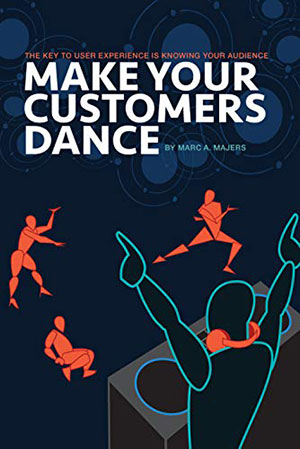Book Specifications
Title: Make Your Customers Dance: The Key to User Experience Is Knowing Your Audience
Author: Marc A. Majers
Formats: Paperback, Kindle
Publisher: Top Rate LLC
Published: December 11, 2020
Pages: 186
ISBN-13: 978-1-64184-472-7
The Dancefloor
Marc wastes no time in introducing the Dancefloor and Dancefloor Pro metaphor. In his construction, the Dancefloor is analogous to a Web site, app, software, or other product or service. It could comprise a variety of materials, be in any location, and the content—the music—could vary. Some Dancefloors are similar, but their experience is unique. A Dancefloor Pro, or UX designer, has the job of making the Dancefloor experience a positive one. Whatever the venue or content, the Dancefloor Pro employs certain methods to get people out on the Dancefloor and having a good time—similar to any well-designed product or service.
As with User Experience, a well-run wedding reception requires certain things. Preparation is key, as is understanding the environment, the number of people who will be there, and the preferences of these people. This involves some research, but it is possible to make the error of confusing stakeholder input with bona fide user research.
In an amusing anecdote, Marc relates the experience of working with a couple who wanted to hear techno music throughout their entire wedding reception—even during cocktails and dinner. As you might imagine, not every guest was enamored of techno. So, when an elderly grandmother—in a wheelchair, to boot—asked him whether it would be possible to play something more traditional for a few songs, Marc sadly had to decline grandma’s request. Predictably, many elderly relatives and friends made early departures. This particular lesson illustrates the dissonance that can happen when stakeholders know what they want and expect their customers to simply accept it. This doesn’t work for software products, and it doesn’t work for wedding receptions.
Marc proceeds to describe various UX concepts in Chapter 2, spending a fair amount of time relating Jesse James Garrett’s The Elements of User Experience to the Dancefloor concept. While there is sometimes a temptation to dispense with the surface plane and visual design as less important than other elements, Marc describes how, as a professional DJ, appearance matters. When performing, he wears a tuxedo. Being presentable conveys professionalism and does not distract anyone. Even when they’re moving about to install their equipment, he and his crew wear clean pants and matching polo shirts to reinforce their sense of professionalism and attention to detail. Attention to small things tells the customer that he’s got the big things covered. The same is true for a Web site. Well-designed Web sites enjoy higher perceptions of credibility than those that might look similar to a Geocities site.
 In learning theory, a constructivist approach suggests that, among other things, the ability to gain new knowledge depends on a learner’s existing knowledge. The experience of trying to explain to people what User Experience is bears out this philosophy. In his book Make Your Customers Dance, Marc Majers illustrates the importance of user experience, while describing its tools and tactics in an accessible way.
In learning theory, a constructivist approach suggests that, among other things, the ability to gain new knowledge depends on a learner’s existing knowledge. The experience of trying to explain to people what User Experience is bears out this philosophy. In his book Make Your Customers Dance, Marc Majers illustrates the importance of user experience, while describing its tools and tactics in an accessible way.